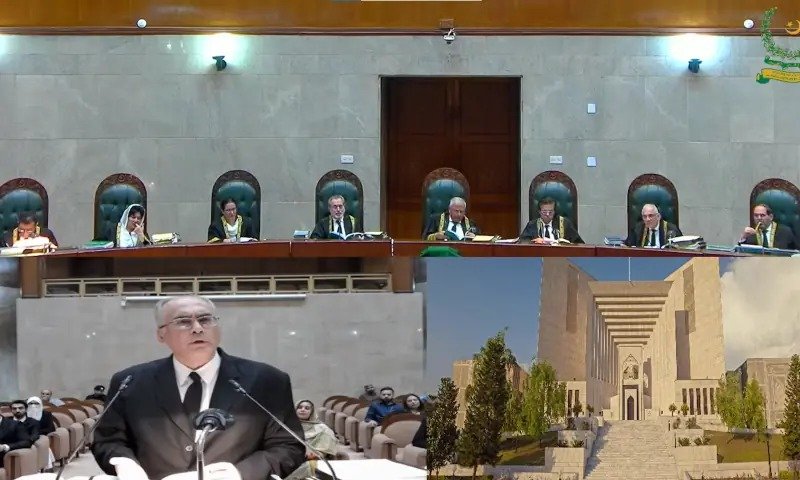Justice Hassan on Thursday observed that disregarding Article 191A — the provision that established the Supreme Court’s Constitutional Bench (CB) under the 26th Amendment — would effectively amount to granting the petitioners “final relief.”
His remarks came as the eight-member CB continued hearing more than thirty petitions challenging the 26th Constitutional Amendment, which was passed during a late-night parliamentary session in October last year.
The Pakistan Tehreek-e-Insaf (PTI) alleged that seven of its lawmakers were abducted and pressured into supporting the bill, while the Balochistan National Party-Mengal (BNP-M) claimed two of its senators were coerced to vote in favour of the changes despite party opposition.
The 26th Amendment has become a focal point of national debate, as it introduced major changes to the judiciary’s structure and powers. It curtailed the Supreme Court’s suo motu authority, limited the Chief Justice’s term to three years, and empowered a Special Parliamentary Committee to select the CJP from among the three senior-most judges. The same amendment also created the Constitutional Bench now tasked with hearing challenges against it.
Hearing Highlights
Advocate Uzair Bhandari, representing the Sunni Ittehad Council (SIC), began his arguments, after which Justice Aminuddin Khan, who heads the bench, adjourned the hearing till November 10.
The bench also comprises Justices Jamal Khan Mandokhail, Mohammad Ali Mazhar, Ayesha Malik, Syed Hasan Azhar Rizvi, Musarrat Hilali, Naeem Akhter Afghan, and Shahid Bilal Hassan.
Early in the hearing, retired Justice Shahid Jamil Khan — who resigned from the Lahore High Court before completing his tenure — appeared before the court. He clarified that his client’s plea was for the implementation of the Practice and Procedure Committee’s decision. The bench allowed him to present his arguments later, after his return from an overseas trip.
Advocate Bhandari then took the podium, noting that the key issue was the “current value” of the 26th Amendment. Justice Mandokhail asked him to clarify which bench had the authority to hear the case before moving into his main arguments.
Bhandari explained that Article 191A, which created the CB, seemed to prevent referring the matter to a full court. Justice Hassan interjected, asking him to define what constituted a “full court,” while Justice Mandokhail quipped whether it would be formed “on wishes or by law.”
Bhandari replied that “full courts are never formed; they already exist,” citing Article 176 of the Constitution as their legal foundation.
Justice Mohammad Ali Mazhar questioned how the bench could ignore the very article — 191A — that formed it. Justice Hassan added that asking the CB to disregard Article 191A while expecting it to issue an order was contradictory, noting, “Ignoring Article 191A would amount to granting you final relief.”
Bhandari argued that his petition did not seek suspension of the amendment, only a determination of its constitutional validity. Justice Ayesha Malik remarked that Article 191A did not remove any existing judicial powers but vested them within the Supreme Court, ensuring no loss of jurisdiction.
The courtroom saw lighter moments when Bhandari pointed out that only male judges were questioning him. Justice Musarrat Hilali responded jokingly, “The ladies have understood the matter,” while Justice Mandokhail added, “The women judges are sharper than me.”
Debate Over Full Court Formation
Petitioners have urged the formation of a full court to hear the case. Lawyers including Hamid Khan (LHCBA), Munir A. Malik (BHCBA), Khwaja Ahmed Hosain (for Afrasiab Khattak), Barrister Salahuddin Ahmed, and Abid Shahid Zuberi have requested a 16-member full court, reflecting the Supreme Court’s strength when the amendment passed in October 2024.
Others argue for a 24-member full court, including six judges appointed since then. The bench, however, continues to question whether the CB has the power to order the creation of such a full court.
Background and Broader Implications
Since October 8, proceedings have been live-streamed on the Supreme Court’s official YouTube channel. The first issue the bench must decide is whether the matter should be heard by a full court of all sitting justices or remain with the existing eight-member CB.
Petitioners, including political parties, bar councils, and independent lawyers, have urged the Supreme Court to strike down the 26th Constitutional Amendment entirely, arguing that it was not passed in accordance with Article 239, which requires a two-thirds majority of lawfully elected members of Parliament.
Alternatively, they have sought partial annulment of provisions that allegedly undermine the judiciary’s independence — a core feature of Pakistan’s Constitution. Contested clauses include those on the Chief Justice’s appointment process, annual performance reviews for high court judges, and the creation of constitutional benches.
The petitions also challenge the Supreme Court (Number of Judges) Act 2024 and the Practice and Procedure Act 2024, claiming these laws are unconstitutional by-products of the 26th Amendment.
The bench will resume proceedings on November 10, when Advocate Bhandari is expected to continue his arguments. The outcome of the case will have far-reaching implications for the balance of power between Parliament and the judiciary, shaping how future constitutional amendments may redefine judicial authority in Pakistan.













